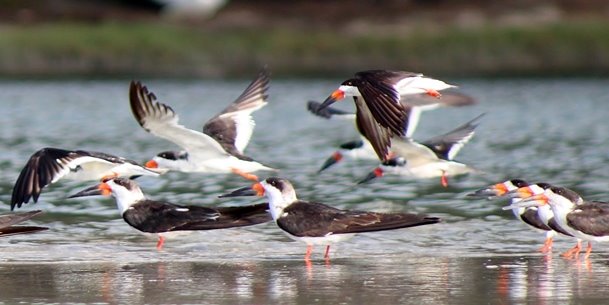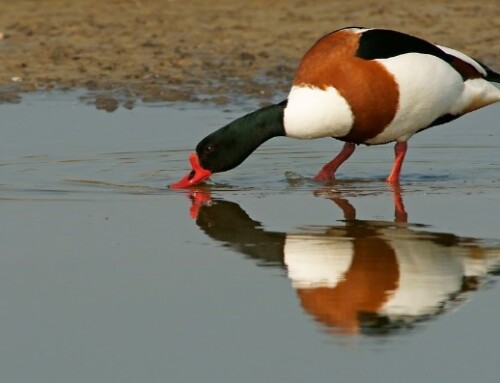Using field photography to study avian moult
LINKED PAPER
Using field photography to study avian moult. Vieira, B.P., Furness, R.W. and Nager, R.G. 2017. IBIS. DOI: 10.1111/ibi.12445. VIEW
When I was a kid in the 1990s, a professional camera was the kind of equipment only photographers would have. At that time, my parents had an amateur analog single lens reflex (SLR) camera. They would always advise me to save the expensive photographic films only for important occasions. Important occasions meant to me finding animals in nature. But trying to photograph birds with those cameras was a waste, because birds would never stay still long enough for a good photograph. During the 2000s, cameras and their accessories became cheaper, more user friendly and much more efficient in capturing fast movements (Hirsch 2008). So nowadays many nature researchers, including myself, have the opportunity to explore the uses of auto-focus digital single lens reflex (DSLR) cameras to study birds.
As methods for taking and improving photographs developed over the decades, data extraction from images became more refined and begun being applied to different fields. Photography equipment and photograph type both evolved. Adaptations began from camera-trapping taking regular pictures to time-lapse photography (Carey 1926, Cowardin & Ashe 1965, Huffeldt & Merkel 2013, Gaglio et al. 2016, Merkel et al. 2016).

In the last years, the use of drones in research has become established (Chabot et al. 2015, Ratcliffe et al. 2015, Vas et al. 2015), as has the use of thermal cameras (Herborn et al. 2015, Jerem et al. 2015) to capture images from parts of an individual to entire colonies. Freezing a moment in time to repeatedly analyse details opened the door for a host of new opportunities, including surveying populations, measuring reproductive success, monitoring stress levels under certain conditions, analysing diet, and even scoring feathers in moult (Snyder et al. 1987, Huffeldt & Merkel 2013, Jerem et al. 2015, Gaglio et al. 2016, Merkel et al. 2016).
Photography has been used both sporadically and systematically to study moult in birds, but there was no test of the effectiveness of scoring feathers in systematic photographs in relation to that of scoring feathers of birds in hand. The results my co-authors and I published in IBIS open the possibility for a much wider use of photography to study moult. Now we are sure scoring is possible, repeatable and reliable. Projects can make use of advantages that photography affords, such as need for less equipment and a smaller field team, feasibility in areas and situations where capturing birds might be difficult, use of photographs as permanent archives, less disturbance caused to birds in relation to captures, and the higher sample size obtained.

Photography to study birds can be further adapted. The use of baits and playback can attract individuals to capture certain images. Use with other methods, such as thermal cameras, could bring insights about how stressful and energy consuming each moulting strategy is to different species. Studies that require individual recognition could use natural marks, such as bill and eye marks, and previous marks such as rings, ink and collars.
The geographic extent of a study also expands with the use of cameras. Training people to photograph birds in different locations is easier than finding specialists in trapping and making available both traps and licences to every professional. Photography is already popular among nature enthusiasts and birdwatchers and these people’s willingness to carry out citizen science may pave the way to large and inclusive initiatives. The possibilities of studies using photography are wide and working together may help researchers to test hypotheses and develop theories.
References and further reading
Carey, H.R. 1926. Camera-trapping: a novel device for wild animal photography. J. Mammal. 7: 278-281. VIEW
Chabot, D. & Bird, D.M. 2015. Wildlife research and management methods in the 21st century: Where do unmanned aircraft fit in? J. UVS 3: 137-155. VIEW
Cowardin, L.M. & Ashe, J.E. 1965. An automatic camera device for measuring waterfowl use. J. Wildl. Manage. 29: 636-640. VIEW
Gaglio, D., Cook, T.R., Connan, M., Ryan, P.G. & Sherley, R.B. 2016. Dietary studies in birds: testing a non‐invasive method using digital photography in seabirds. Methods Ecol. Evol. DOI: 10.1111/2041-210X.12643. VIEW
Herborn, K.A., Graves, J.L., Jerem, P., Evans, N P., Nager, R., McCafferty, D.J. & McKeegan, D.E.F. 2015. Skin temperature reveals the intensity of acute stress. Physiol. Behav. 152: 225-230. VIEW
Hirsch, R. 2008. Seizing the light: A history of photography. 2nd ed. McGraw-Hill Education, New York.
Huffeldt, N.P. & Merkel, F R. 2013. Remote time-lapse photography as a monitoring tool for colonial breeding seabirds: a case study using thick-billed murres (Uria lomvia). Waterbirds 36: 330-341. VIEW
Jerem, P., Herborn, K., McCafferty, D., McKeegan, D. & Nager, R. 2015. Thermal imaging to study stress non-invasively in unrestrained birds. J. Vis. Exp. 105: 53184. VIEW
Merkel, F.R., Johansen, K.L. & Kristensen, A.H. 2016. Use of time‐lapse photography and digital image analysis to estimate breeding success of a cliff‐nesting seabird. J. Field Ornithol. 87: 84-95. VIEW
Ratcliffe, N., Guihen, D., Robst, J., Crofts, S., Stanworth, A. & Enderlein, P. 2015. A protocol for the aerial survey of penguin colonies using UAVs. J. UVS 3: 95-101. VIEW
Snyder, N.F.R., Johnson, E.V. & Clendenen, D.A. 1987. Primary molt of California Condors. Condor 89: 468-485. VIEW
Vas, E., Lescroël, A., Duriez, O., Boguszewski, G. & Grémillet, D. 2015. Approaching birds with drones: first experiments and ethical guidelines. Biol. Lett. 11: 20140754. VIEW
Image credit
Featured image: Black Skimmers Rynchops niger moulting with open wings during take-off © Bianca Vieira
If you want to write about your research in #theBOUblog, then please see here.





